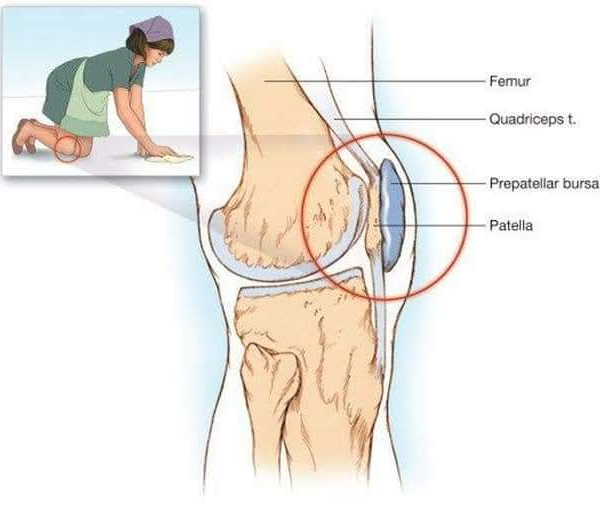
2024-01-28T04:48:57
Physiotherapy clinic in Tambaram Are you Looking for Physiotherapy Treatment in Tambaram, Sunshine Super Speciality Physiotherapy Clinic, We Provide Electrotherapy, Exercise and Manual Therapy, Orthopedic, Neuro, Cardio, Pediatric, Sports and Geriatric Rehabilitation, Post Operative Physiotherapy Treatment, Fracture Rehabilitation, pain free movement. Housemaid knee/Prepatellar bursitis. Prepatellar bursitis, also known as housemaid's knee, is caused by inflammation of the prepatellar bursa in individuals who spend long periods kneeling, such as housemaids, clergy, and gardeners Symptoms. Often, people describe sharp needle-like pain when kneeling. Also, stiffness of knee movements and general tightness are common. In cases of infection, the skin is hot to touch, and you may feel unwell with a fever. Also, it is common to have an indent in the knee dues to swelling. Causes. There are a number of different things that can cause housemaid's knee (prepatellar bursitis): A sudden, one-off injury to the knee Recurrent minor injury to the knee This usually happens after spending long periods of time kneeling down, putting pressure on the kneecap (patella). Historically, this was typical of housemaids who spent long periods of time on their knees scrubbing floors; hence, the term housemaid's knee. Infection The fluid in the prepatellar bursa sac can become infected and cause inflammation within a bursa (bursitis). This is known as septic bursitis. It is particularly common in children with housemaid's knee. This usually follows a cut, scratch or injury to the skin on the surface of the knee which allows germs (bacteria) to spread infection into the bursa. Another inflammatory disease If you already have an inflammatory disease such as rheumatoid arthritis, you have an increased risk of developing a bursitis. Rheumatoid arthritis is a form of arthritis that causes inflammation, pain and swelling of joints. Gout If you have gout or pseudogout you have an increased risk of developing a bursitis. Gout is caused by a build-up of uric acid crystals. Uric acid is a chemical in the blood that is usually harmless and passed out with the urine. In gout, it builds up and collects within a joint, causing pain, inflammation and joint swelling. Treatment. Housemaid's knee treatment using medicines If housemaid's knee becomes more troublesome, your doctor may suggest that they draw out the fluid from the bursa, using a small needle. They can then inject a steroid medicine into the bursa to counteract the inflammation. The idea is that the fluid will no longer accumulate. Recovery Process of Housemaids Knee Follow your treatment program. Rest. Ice therapy. Stretching exercises. Anti-inflammatory medication (only when prescribed) Be patient – the results will take time. Persevere through the healing process – it's worth it in the end. Flucloxacillin (500 mg four times daily) is the preferred antibiotic. For people over 70 kg, prescribe 1000 mg four times daily. Exercises. Heel slide Lie on your back with your affected knee straight. Your good knee should be bent. Bend your affected knee by sliding your heel across the floor and toward your buttock until you feel a gentle stretch in your knee. Hold for about 6 seconds, and then slowly straighten your knee. Repeat 8 to 12 times. Injection Steroid Injections: Cortisone injections into the bursa can help to reduce swelling and pain associated with housemaids knee. You can find out more in the knee injections section. Antibiotics: If your housemaids knee is due to an infection, your doctor will prescribe you antibiotics. Can knee bursitis be drained? A doctor can puncture the bursa with a hollow needle (cannula) to draw out the excess fluid. But this technique is usually not a permanent solution – even when repeated several times: The fluid quickly fills up again, and each time it is drained there is a risk that bacteria could infect the bursa. Removing the fluid will decrease the pressure, relieve pain, and improve movement of the joint. Sometimes, a medicine is injected following removal of the fluid to help treat tendonitis or bursitis. There may be other reasons for your healthcare provider to recommend a joint aspiration. SUNSHINE ® SUPER SPECIALITY PHYSIOTHERAPY CLINIC - #DrParthiban #Sunshinephysioclinic.in #Physiotherapyclinicintambaram DR.M.P. PARTHIBAN.M.P.T (Ortho), Chief Orthopedic Physiotherapist, Call for Appointments: - 9345122177 East Tambaram, CHENNAI

